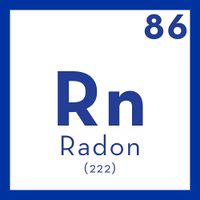Difference between revisions of "General Information on Radon"
m (Karen Clement moved page General Information: Radon to General Information on Radon) |
(→What is Radon?) |
||
| Line 8: | Line 8: | ||
| + | [[file:Radon_PTable.jpg|200px|thumb]] | ||
Radon can also come from water and building materials, but the amount is usually very small. | Radon can also come from water and building materials, but the amount is usually very small. | ||
Radon cannot be seen, and has no smell. The only way to know how much radon is in the air is to [[Measuring and Reducing Radon Levels in your Home|measure it]]. | Radon cannot be seen, and has no smell. The only way to know how much radon is in the air is to [[Measuring and Reducing Radon Levels in your Home|measure it]]. | ||
| Line 20: | Line 21: | ||
'''[[#Top|Back to Top]]''' | '''[[#Top|Back to Top]]''' | ||
| − | |||
==Risk of Exposure to Radon== | ==Risk of Exposure to Radon== | ||
Revision as of 16:32, 1 October 2019

Introduction
Contents
What is Radon?
Radon (chemical symbol: Rn) is a natural part of the environment. It is a radioactive gas that comes mainly from soil and rock, and is a normal part of the air we breathe.
Radon can also come from water and building materials, but the amount is usually very small. Radon cannot be seen, and has no smell. The only way to know how much radon is in the air is to measure it.
Radon makes up the largest part of natural Sources of Radiation Exposure.
There is usually less radon outdoors than indoors, since radon can concentrate in enclosed spaces. Exposure to radon outdoors is generally not an issue, so we normally focus on Exposure to Radon at Home and in indoor workplaces.
Radon is the second leading cause of lung cancer after smoking. Exposure to higher levels of radon for a long time can increase your risk of lung cancer.
Information on measuring and, if necessary, reducing radon levels, is available for homeowners, businesses, and government authorities.
Risk of Exposure to Radon
There is strong evidence that exposure to radon can cause lung cancer. Radon exposure is the second leading cause of lung cancer after smoking.
Smokers are more at risk from radon exposure than non-smokers. A lifetime of exposure to radon at 100 Bq/m3 increases the risk of lung cancer by 0.1% for non-smokers, and 2% for smokers.
More precisely, for an average radon concentration of 100 Bq/m3, the lifetime risk of lung cancer for non-smokers is 0.5% (compared with a risk of 0.4% in the absence of radon). For lifelong smokers, the risk is 12% (compared with a risk of 10% in the absence of radon).
From the WHO Factsheet on Indoor Radon
"Radon is the most important cause of lung cancer after smoking. It is estimated that radon causes between 3–14% of all lung cancers in a country, depending on the average radon level and the smoking prevalence in a country.”
“… the risk of lung cancer increases … with increasing radon exposure.”
| The United Nations Scientific Committee on the Effects of Atomic Radiation (UNSCEAR) is the leading international body on radiation levels and effects. Visit the UNSCEAR website or read the UNEP report on "Radiation Effects and Sources" based on UNSCEAR work to learn more |
Units of Measure
Radon Measurements
A becquerel is a measure of radioactivity. One becquerel (Bq) is equal to one radioactive decay per second.
Radon concentrations in air are usually measured in becquerels per cubic meter (Bq/m3). That’s the amount of radon (becquerels) in a volume of air (cubic metre).
Worldwide, the average radon concentration in outdoor air is around 10 Bq/m3.
Some countries still use older units of picocuries per litre (pCi/L). 10 Bq/m3 = 0.27 pCi/L.
Potential Alpha Energy Concentration
In some circumstances, it’s more important to measure the level of radon progeny instead of the radon itself, specifically the Potential Alpha Energy Concentration (PAEC). This is the sum of the alpha particle decay energy of all the short-lived progeny of radon in a volume of air. The SI unit is joule per cubic metre (J m-3).
Historically, PAEC was measured in units of Working Levels (WL). 1 WL= 2.08 x 10-5J m-3

More In-Depth Information
If you are looking for something more extensive look no further below are a collection of related links and articles that can provide more information on this topic!
Risk of Exposure to Radon
| Lung Cancer Risk from Radon and Progeny and Statement on Radon | ICRP Publication 115 |
| WHO Factsheet on Indoor Radon | www.who.int |
| Expert Summary of ICRP Recommendations on Radon | ICRP Radon Summary |
| Radiological Protection against Radon Exposure | ICRP Publication 126 |
| WHO Handbook on Indoor Radon | Handbook |
| UNEP report on Radiation Effects and Sources | https://wedocs.unep.org/ |
